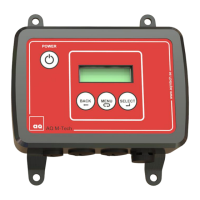14 Ultrasound Controller Manual
SETTINGS
Through the SETTINGS-menu the parameters of the Air Sensor can be set.
Select SET TYPE to set the type of Air Sensor connected. This tells the Ultrasound Controller to
make the correct adjustments for this Air Sensor type.
Select SET DIAMETER to set it to the diameter of the connected Air Sensor or as close as
possible. This tells the Ultrasound Controller to make the correct adjustments for this Air Sensor
diameter.
Select SET SENSITIVITY to set the sensitivity. This determines how sensitive the Air Sensor is for
bubbles.
SENSITIVITY can be set to high, medium, low, very low and very very low. Detectable bubble size is
somewhat dependent on Air Sensor inner diameter:
At high sensitivity, a single bubble of approximately 1-60μl can be detected depending on Air
Sensor diameter: SAC10,FCS10: 1μl, SAC22,FCS22: 6μl, SAC35,FCS35: 8μl, SAC46,FCS46:
80ul, DAP6,APS6: 3μl, DAP10,APS10: 20μl, DAP22,APS22: 60μl
At medium sensitivity, a single bubble of approximately 10-150μl can be detected depending on Air
Sensor diameter: SAC10,FCS10: 10μl, SAC22,FCS22: 30μl, SAC35,FCS35: 40μl,
SAC46,FCS46: 170ul, DAP6,APS6: 30μl, DAP10,APS10: 60μl, DAP22,APS22: 150μl
At low sensitivity, a single bubble of approximately 500-1200μl can be detected depending on Air
Sensor diameter: SAC10,FCS10: 500μl, SAC22,FCS22: 900μl, SAC35,FCS35: 1000μl,
SAC46,FCS46: 5000ul, DAP6,APS6: 200μl, DAP10,APS10: 500μl, DAP22,APS22: 1200μl
Sensitivity is also affected by liquid flow rate. At a flow rates above 4m/s sensitivity starts
decreasing. Many small bubbles together may also detect as if they were a big bubble. Even tiny,
microscopic bubbles may cause detection if there are very many of them.
High, medium and low sensitivity are the normal measurements.
At very low and very very low sensitivity, a different measuring technique is used (WR-technique).
This technique measures the presence of liquid or no liquid, making the Air Sensor very
insensitive for bubbles. It can be used for Air Sensors DAP and APS with diameter ≥ 6mm and Air
Sensor SAC with diameter ≥ 22mm. There is temperature dependence and this setting should not
be used if temperature variation between calibration and operation is more than ±5ºC.
Select SET FILTER to set the filter-time. It determines how the detection-data is filtered. FILTER
can be set to either integrate 1ms - 3s or delay 300ms - 10s.
Integrate means integrating (adding) the duration of each bubble in the measuring zone. When
the sum becomes higher than the integrate time, air will be indicated. Whenever liquid is next time
indicated, the integration-process will start over.
Delay means that air will only be indicated when air has been continuously detected for a time
longer than the delay time.
Long FILTER delay and low SENSITIVITY is useful if some quantity of bubbles are acceptable.
Short FILTER integrate and high SENSITIVITY is useful when almost every bubble must be detected.
Select SET FREQUENCY to set the ultrasound frequecy that is used to detect bubbles. Normally it
should be set to Auto, then the frequency that works best is automatically selected. However for
some liquids it works better to set it manually. (For example acetic acid is better to set to 2,0MHz)
Select SET RELAY to set how the relays should act. There are four relays each with one normally
open contact (at power off and when sensor is not connected the relay is open). Each relay can
be set independently. Choose between Closed with air or closed with liquid and choose between
Air Sensor 1 and Air Sensor 2. The duration of air being indicated is minimum 0,5 second even if
the bubble is detected much shorter time (to make sure the indication of air is registered).

